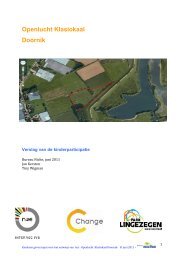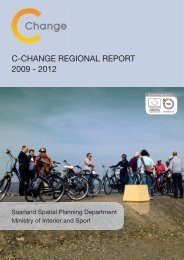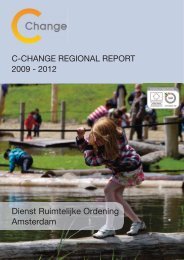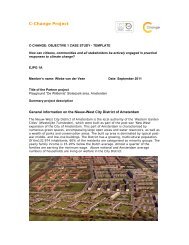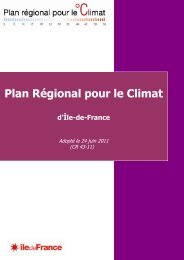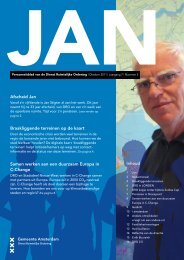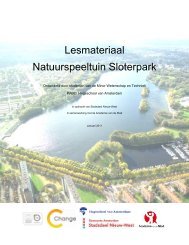Amsterdam 2040
Amsterdam 2040
Amsterdam 2040
- No tags were found...
You also want an ePaper? Increase the reach of your titles
YUMPU automatically turns print PDFs into web optimized ePapers that Google loves.
y Wouter van der Veurw.vanderveur@dro.amsterdam.nlThe maps tellthe storya ‘Plan Map’ of the StructuralPlan 1985.b ‘Plan Map’ of the StructuralPlan 1996.c ‘Vision Map’ of the StructuralVision 2011.On the cover of the Structural Vision there is amap of the <strong>Amsterdam</strong> Metropolitan Area inthe year <strong>2040</strong>. This map stands out in the seriesof maps from the structural plans of previousdecades. It is colourful and lively, and bycomparison with its predecessors looks slightlyless clinical. What are the key differences?The most striking difference is undoubtedly theframing. While the maps in previous structuralplans were exclusively focused on <strong>Amsterdam</strong>’smunicipal territory, the new Structural Vision mapis about the <strong>Amsterdam</strong> Metropolitan Area.This new outlook on <strong>Amsterdam</strong> as the core city ofthe much larger metropolitan region results in aslight tilting of the Structural Vision’s maps, so thatall the municipalities are properly in the picture.This broadening of the outlook is not the onlything that has changed. The most important mapin previous structural plans was always the ‘PlanMap’, in which <strong>Amsterdam</strong> was depicted in largecoloured panels that indicated the functions of thevarious areas. The zoning plans of city boroughswere appraised against that plan map. The mostimportant map in the new Structural Vision isthe vision map. Instead of large panels it usessubtle shadings that indicate the most importantdevelopmental thrusts in the metropolitan area.The map dovetails with the new philosophy ofthe Structural Vision and tells a story. The map isthe composite representation of the four thrusts:the ‘rolling out’ of the city centre, the renewedinterest in the waterfront, the economic dynamismof the southern flank and the increasinglyinterwoven urban and metropolitan landscapes.The vision map tells at a single glance where thedynamism is likely be highest over the comingdecades. Where possible, the narrative of theStructural Vision is illustrated with many details,such as the development of major streets orqualitative impulses in public spaces.Another change in course compared to previousstructural plans concerns the role of maps in theStructural Vision’s development. Urban plannersand designers worked on the vision’s maps fromday one, never approaching the task from a singlesectoral perspective or an isolated issue butconsistently based on an integral vision for the cityand the metropolis. The maps were honed andpolished from the very start. This means that themaps do not illustrate just the final conclusionof the discussions about the city’s future, buthave chiefly served as guidance throughout theprocess. Discussions were focused more sharplyby showing where strengths lie in maps, whichalso revealed where there are bottlenecks orwhere conflicts arise.The City Council ratified the Structural Visionin February 2011, so the vision map can now beregarded as an inspiring beacon for the future.The earlier structural plans were primarily instrumentsof verification and the accompanying planmaps served as a benchmark for assessment, butthe vision map serves a totally different purpose:to kindle enthusiasm and stimulate by outlining anattractive vision of the future.a b cusable for recreational purposes, which are aspects inwhich they sometimes falls short. The improvement isoften a question of fairly minimal spatial interventions,such as the laying of missing links in the recreationalcycle network, as on the route between <strong>Amsterdam</strong>and Muiden, or opening a teahouse in a park.This could, for example, augment the quality of theRembrandtpark, the Vliegenbos woodland area, theFlevopark and the environs of the Sloterplas lake.Extra marinas are planned on the IJ waterway forrecreational cruising and the sailing possibilities for‘sloops’ in and around the city will be expanded.6 Converting to sustainable energyAt some point fossil fuels will be exhausted. The citymust be ready for the post-fossil fuel era. <strong>Amsterdam</strong>must therefore become more energy-efficient. A bigstep can be made by rendering the existing housing>01 | 201111





